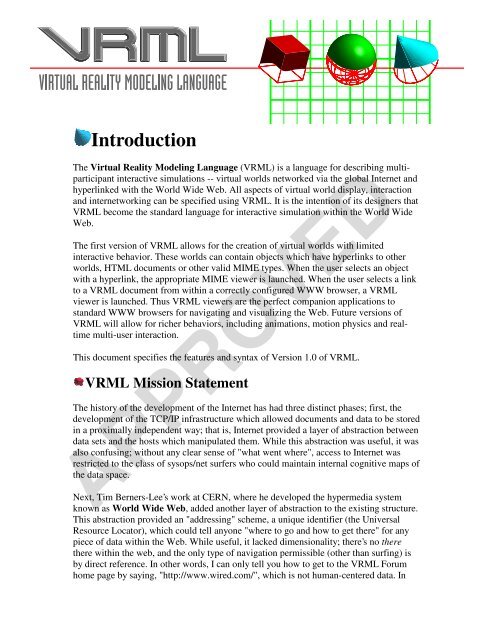Create successful ePaper yourself
Turn your PDF publications into a flip-book with our unique Google optimized e-Paper software.
Introduction<br />
The Virtual Reality Modeling Language (VRML) is a language for describing multiparticipant<br />
interactive simulations -- virtual worlds networked via the global Internet and<br />
hyperlinked with the World Wide Web. All aspects of virtual world display, interaction<br />
and internetworking can be specified using VRML. It is the intention of its designers that<br />
VRML become the standard language for interactive simulation within the World Wide<br />
Web.<br />
The first version of VRML allows for the creation of virtual worlds with limited<br />
interactive behavior. These worlds can contain objects which have hyperlinks to other<br />
worlds, HTML documents or other valid MIME types. When the user selects an object<br />
with a hyperlink, the appropriate MIME viewer is launched. When the user selects a link<br />
to a VRML document from within a correctly configured WWW browser, a VRML<br />
viewer is launched. Thus VRML viewers are the perfect companion applications to<br />
standard WWW browsers for navigating and visualizing the Web. Future versions of<br />
VRML will allow for richer behaviors, including animations, motion physics and realtime<br />
multi-user interaction.<br />
This document specifies the features and syntax of Version 1.0 of VRML.<br />
VRML Mission Statement<br />
The history of the development of the Internet has had three distinct phases; first, the<br />
development of the TCP/IP infrastructure which allowed documents and data to be stored<br />
in a proximally independent way; that is, Internet provided a layer of abstraction between<br />
data sets and the hosts which manipulated them. While this abstraction was useful, it was<br />
also confusing; without any clear sense of "what went where", access to Internet was<br />
restricted to the class of sysops/net surfers who could maintain internal cognitive maps of<br />
the data space.<br />
APPROVED<br />
Next, Tim Berners-Lee’s work at CERN, where he developed the hypermedia system<br />
known as World Wide Web, added another layer of abstraction to the existing structure.<br />
This abstraction provided an "addressing" scheme, a unique identifier (the Universal<br />
Resource Locator), which could tell anyone "where to go and how to get there" for any<br />
piece of data within the Web. While useful, it lacked dimensionality; there’s no there<br />
there within the web, and the only type of navigation permissible (other than surfing) is<br />
by direct reference. In other words, I can only tell you how to get to the VRML Forum<br />
home page by saying, "http://www.wired.com/", which is not human-centered data. In
















